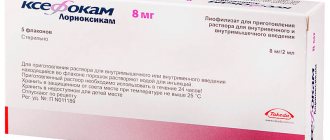Ferinject®
The drug should be administered intravenously (stream or drip) and by direct injection into the venous portion of the dialysis system.
Before opening, the bottles should be inspected for possible sediment and damage. Only a homogeneous solution without sediment can be used.
Drip administration:
Ferinject® can be administered intravenously in a maximum single dose of up to 20 ml (1000 mg iron), which should not exceed 0.3 ml (15 mg iron)/kg body weight or the calculated cumulative dose. Ferinject® should not be administered by drip in a dose of 20 ml more than once a week. Immediately before drip administration of the drug, it should be diluted with a sterile 0.9% sodium chloride solution for injection in the ratios indicated in the table.
Guidelines for diluting Ferinject® for drip administration
| Ferinject® | Iron | Sterile 0.9% sodium chloride solution for injection | Minimum administration time |
| 2 to < 4 ml | 100 to <200 mg | no more than 50 ml | — |
| from 4 to < 10 ml | 200 to <500 mg | no more than 100 ml | 6 min |
| 10 to < 20 ml | 500 to <1000 mg | no more than 250 ml | 15 minutes |
Note: to maintain the stability of the drug, dilution to a concentration of less than 2 mg iron/ml is not allowed.
Jet introduction:
Ferinject® can be administered intravenously in a bolus at a maximum dose of up to 4 ml (200 mg) 1 time/day, but not more than 3 times a week.
Dose calculation
The cumulative dose of the drug in mg of elemental iron required to restore hemoglobin Hb levels and replenish iron reserves is calculated individually in accordance with the general iron deficiency in the body using the formula:
Cumulative iron deficiency (mg) = body weight (kg) × [target Hb* - actual Hb] (g/dl)** × 2.4*** + iron storage [mg]****
* Target Hb for body weight less than 35 kg = 13 g/dl, respectively 8.1 mmol/l. Target Hb for body weight 35 kg or more = 15 g/dL, respectively 9.3 mmol/L.
** To convert Hb (mM) to Hb (g/dL), multiply Hb (mM) by a factor of 1.61145.
*** Coefficient 2.4=0.0034×0.07×10,000;
0.0034: iron content of hemoglobin approximately = 0.34%;
0.07: blood volume approximately = 7% body weight;
10,000: conversion factor 1 g/dL = 10,000 mg/L.
**** Iron depot for body weight less than 35 kg = 15 mg/kg body weight. Iron depot for body weight 35 kg or more = 500 mg.
For patients weighing less than 66 kg
the calculated cumulative iron dose should be rounded down to the nearest 100 mg.
For patients weighing more than 66 kg
the calculated cumulative iron dose should be rounded up to the nearest 100 mg.
If there is a subsequent need to maintain the target Hb level and other laboratory indicators of iron stores within acceptable limits, it is possible to continue treatment with Ferinject® at a minimum maintenance dose.
Maximum tolerated single dose.
An adequate cumulative dose should be calculated individually for each patient and should not be exceeded.
Ferinject solution for intravenous administration 50 mg/ml 2 ml bottle 5 pcs. in Moscow
IV
- stream or drip (infusion) and by direct injection into the venous section of the dialysis system.
Before use, bottles should be inspected for possible sediment and damage. Only a homogeneous solution without sediment can be used.
Ferinject® should be used in departments that have the necessary equipment to provide emergency medical care in the event of anaphylactic reactions. Each patient should be observed for the development of signs or symptoms of hypersensitivity reactions for at least 30 minutes after each administration of iron carboxymaltose solution (see "Special Instructions").
Intravenous infusion:
Ferinject® can be administered intravenously (infusion) in a maximum single dose of up to 1000 mg of iron (maximum 20 mg iron/kg). You cannot prescribe 1000 mg of iron (20 ml of Ferinject®) intravenously (infusion) more than once a week. Immediately before infusion administration, Ferinject® must be diluted with a sterile 0.9% sodium chloride solution for injection in the ratios indicated in Table 1.
Table 1
Guidelines for dilution of Ferinject® for infusion
| Ferinject®, ml | Iron, mg | Sterile 0.9% sodium chloride solution for injection, ml1 | Minimum administration time, min |
| >2 to 4 | >100 to 200 | 50 | — |
| >4 to 10 | >200 to 500 | 100 | 6 |
| >10 to 20 | >500 to 1000 | 250 | 15 |
1 To maintain the stability of the drug, dilution to a concentration of less than 2 mg of iron/ml is not allowed (the volume of the Ferinject® solution is not taken into account).
Jet injection:
Ferinject® can be administered intravenously as a bolus, in a maximum single dose of up to 4 ml (200 mg of iron) per day, but not more than 3 times a week.
Determination of the cumulative dose of iron:
The cumulative dose for iron replenishment with iron carboxymaltose is determined based on the patient's body weight and Hb level and should not be exceeded. Table 2 below should be used to determine the cumulative iron dose.
table 2
Cumulative iron dose based on patient weight and Hb level
| Hb, g/dl | Patients weighing between 35 and <70 kg | Patients weighing ≥70 kg |
| <10 | 1500 mg | 2000 mg |
| ≥10 | 1000 mg | 1500 mg |
Note: In patients weighing less than 35 kg, the cumulative iron dose should not exceed 500 mg.
When determining iron requirements in overweight patients, it should be based on the normal ratio of body weight to blood volume.
Patients with an Hb value ≥14 g/dL should be given an initial dose of 500 mg iron and iron levels should be checked before subsequent administrations.
After repletion, regular assessments should be performed to ensure that iron levels are normalized and maintained.
Maximum tolerated single dose:
a single dose of the drug should not exceed 1000 mg of iron (20 ml) per day or 20 mg of iron (0.4 ml) per 1 kg. A dose of 1000 mg iron (20 ml) should not be administered more than once a week.
Use of the drug for chronic kidney disease requiring hemodialysis.
The maximum daily dose of 200 mg should not be exceeded in patients with chronic kidney disease requiring hemodialysis.
Ferinject®
The dose calculation of Ferinject® is carried out on the basis of the following step-by-step approach: determining the individual need for iron, calculating and prescribing the dose(s) of iron, assessing the saturation of the patient’s body with iron after administration.
Step 1: Determine Individual Iron Requirements
The individual iron requirement for replenishment with Ferinject® is determined based on the patient’s body weight and hemoglobin (Hb) level. Use the table below to determine your iron requirements.
Determining iron requirements
| NH | Patients with weight | |||
| g/dl | mmol/l | less than 35 kg | from 35 to < 70 kg | from 70 kg and above |
| < 10 | <6.2 | 500 mg | 1500 mg | 2000 mg |
| from 10 to < 14 | from 6.2 to <8.7 | 500 mg | 1000 mg | 1500 mg |
| ≥ 14 | >8.7 | 500 mg | 500 mg | 500 mg |
Iron deficiency must be confirmed by laboratory tests.
When determining iron requirements in overweight patients, it should be based on the normal ratio of body weight to blood volume.
Step 2: Calculation and prescription of the maximum individual dose(s) of iron
Based on the iron requirement determined as described above, the appropriate dose(s) of Ferinject® should be administered, taking into account the following conditions:
With a single administration of Ferinject®, the following levels should not be exceeded:
- 15 mg iron/kg body weight (when prescribed as an intravenous injection) or 20 mg iron/kg body weight (when prescribed as an intravenous infusion);
— 1,000 mg of iron (20 ml of Ferinject®).
The maximum recommended total dose of Ferinject® is 1000 mg of iron (20 ml of Ferinject®) per week.
Step 3: Assessing the patient's iron saturation after administration
After iron replenishment, regular assessments should be performed to ensure that iron levels are normalized and maintained.
Iron levels should be reassessed by a clinician based on the individual patient's condition. Hb levels should be assessed no earlier than 4 weeks after the last use of Ferinject® to allow sufficient time for erythropoiesis and iron absorption. If the patient needs to further replenish iron stores in the body, then the iron requirement must be recalculated using the data in the above table for determining iron requirements.
Use of the drug for chronic kidney disease requiring hemodialysis
The single maximum daily dose in hemodialysis patients with chronic kidney disease should not exceed 200 mg of iron.
Mode of application
Intravenously - stream or drip (infusion) and by direct injection into the venous section of the dialysis system. Ferinject® should not be used subcutaneously or intramuscularly.
Before use, bottles should be inspected for possible sediment and damage. Only a homogeneous solution without sediment can be used.
Ferinject® should be used in departments that have the necessary equipment to provide emergency medical care in the event of anaphylactic reactions. Each patient should be observed for the development of signs or symptoms of hypersensitivity reactions for at least 30 minutes after each administration of iron carboxymaltose solution (see section "Special Instructions").
Intravenous jet injection
Ferinject® can be administered intravenously undiluted. The maximum single dose is 15 mg iron/kg body weight, but should not exceed 1000 mg iron (20 ml Ferinject®).
Rate of administration of intravenous injection of Ferinject®
| Ferinject® | Equivalent dose gland | Infusion rate/minimum infusion time |
| > 2 to 4 ml | >100 to 200 mg | Minimum time administration is not prescribed |
| > 4 to 10 ml | >200 to 500 mg | 100 mg iron/min |
| > 10 to 20 ml | > 500 to 1000 mg | 15 minutes |
Intravenous infusion
Ferinject® can be administered intravenously by drip (infusion) in a maximum single dose of up to 1000 mg of iron (maximum 20 mg of iron/kg body weight). You cannot administer 1000 mg of iron intravenously (infusion) (20 ml of Ferinject® more than once a week. Immediately before infusion administration, the drug must be diluted with a sterile 0.9% sodium chloride solution for injection in the ratios indicated in the table:
Guidelines for dilution of Ferinject® for infusion
| Ferinject® | Iron | Amount of sterile 0.9% sodium chloride solution for injection1 | Minimum administration time |
| > 2 to 4 ml | >100 to 200 mg | 50 ml | — |
| > 4 to 10 ml | >200 to 500 mg | 100 ml | 6 min |
| > 10 to 20 ml | > 500 to 1000 mg | 250 ml | 15 minutes |
Note:
1 To maintain the stability of the drug, dilution to concentrations less than 2 mg of iron/ml is not allowed (the volume of the Ferinject® solution is not taken into account).
Ferinject IV solution 50 mg/ml 2 ml N5 (Nycomed)
IV - stream or drip and by injection into the venous section of the dialysis system. Before opening, you need to inspect the bottles for possible sediment and damage. Only a homogeneous solution without sediment can be used. Drip administration You cannot prescribe drip administration of 20 ml of Ferinject more than once a week. Can be administered intravenously in a maximum single dose of up to 20 ml of Ferinject (1000 mg iron), which should not exceed 0.3 ml of Ferinject (15 mg iron) per 1 kg of body weight or calculated cumulative dose. Injection of Ferinject can administered intravenously in a stream, in a maximum single dose of up to 4 ml (200 mg of iron) per day, but not more than 3 times a week. Dose calculation The cumulative dose of the drug in mg of elemental iron required to restore hemoglobin (Hb) levels and replenish iron reserves is calculated individually in accordance with the general iron deficiency in the body using the formula: Cumulative iron deficiency [mg] = body weight [kg] × ( target Hb* − actual Hb) [g/dl]** × 2.4*** + reserve iron depot [mg]**** —————————————————— ————— * Target Hb for body weight less than 35 kg = 13 g/dl (respectively 8.1 mmol/l). Target Hb for body weight 35 kg or more = 15 g/dL (respectively 9.3 mmol/L). ** To convert Hb [mM] to Hb [g/dL]: multiply Hb [mM] by a factor of 1.61145. *** Coefficient 2.4 = 0.0034×0.07×10000, where: 0.0034 - hemoglobin iron content is approximately 0.34%; 0.07 - blood volume is approximately equal to 7% of body weight; 10000 - conversion factor: 1 g/dl = 10000 mg/l. **** Iron deposited at body weight less than 35 kg = 15 mg/kg body weight; iron deposited with a body weight of 35 kg and more = 500 mg. For patients ≤66 kg: the calculated cumulative iron dose should be rounded down to the nearest 100 mg. For patients >66 kg: calculated cumulative iron dose should be rounded up to the nearest 100 mg. If there is a subsequent need to maintain the target Hb level and other laboratory indicators of iron stores within acceptable limits, it is possible to continue treatment with Ferinject at a minimum maintenance dose. Maximum tolerated single dose An adequate cumulative dose of the drug should be calculated for each patient individually and should not exceed the calculated dose.
FERINJECT
Directions for use and doses
Intravenous - stream or drip (infusion) and by direct injection into the venous section of the dialysis system.
Before use, bottles should be inspected for possible sediment and damage. Only a homogeneous solution without sediment can be used.
Ferinject® should be used in departments that have the necessary equipment to provide emergency medical care in the event of anaphylactic reactions. Each patient should be observed for the development of signs or symptoms of hypersensitivity reactions for at least 30 minutes after each administration of iron carboxymaltose solution (see section "Special Instructions").
Intravenous infusion:
Ferinject® can be administered intravenously by drip (infusion) in a maximum single dose of up to 1000 mg of iron (up to 20 mg of maximum iron/kg body weight). You cannot administer 1000 mg of iron (20 ml Ferinject®) intravenously (infusion) more than once a week. Immediately before infusion administration, the drug must be diluted with a sterile 0.9% sodium chloride solution for injection in the ratios indicated in the table:
Guidelines for dilution of Ferinject® for infusion
| Ferinject® | Iron | Amount of sterile 0.9% sodium chloride solution for injection1 | Minimum administration time |
| > 2 to 4 ml | >100 to 200 mg | 50 ml | — |
| > 4 to 10 ml | >200 to 500 mg | 100 ml | 6 min. |
| > 10 to 20 ml | > 500 to 1000 mg | 250 ml | 15 minutes. |
Note:
1 To maintain the stability of the drug, dilution to concentrations less than 2 mg of iron/ml is not allowed (the volume of the Ferinject® solution is not taken into account).
Jet injection:
Ferinject® can be administered intravenously as a bolus in a maximum single dose of up to 4 ml (200 mg of iron) per day, but not more than 3 times a week.
Determination of cumulative iron dose
The cumulative dose for iron replenishment with iron carboxymaltose is determined based on the patient's body weight and hemoglobin (Hb) level and should not be exceeded. The table below should be used to determine your cumulative iron dose.
Cumulative iron dose based on patient weight and hemoglobin (Hb) level
| Hb (g/dl) | Patients weighing between 35 and <70 kg | Patients weighing ≥70 kg |
| <10 | 1500 mg | 2000 mg |
| ≥10 | 1000 mg | 1500 mg |
Note: In patients weighing less than 35 kg, the cumulative iron dose should not exceed 500 mg.
When determining iron requirements in overweight patients, it should be based on the normal ratio of body weight to blood volume.
Patients with an Hb value ≥ 14 g/dL should be given an initial dose of 500 mg iron and iron levels should be checked before subsequent administrations.
After repletion, regular assessments should be performed to ensure that iron levels are normalized and maintained.
Maximum tolerated single dose:
A single dose of the drug should not exceed 1000 mg of iron (20 ml) per day or 20 mg of iron (0.4 ml) per kg of body weight. A dose of 1000 mg iron (20 ml) should not be administered more than once a week.
Use of the drug for chronic kidney disease requiring hemodialysis
The maximum daily dose of 200 mg should not be exceeded in patients with chronic kidney disease requiring hemodialysis.


